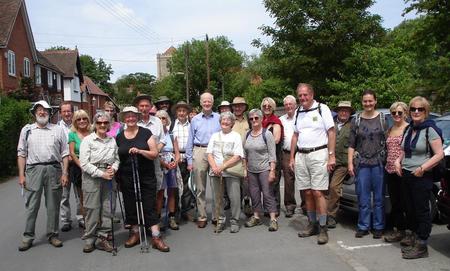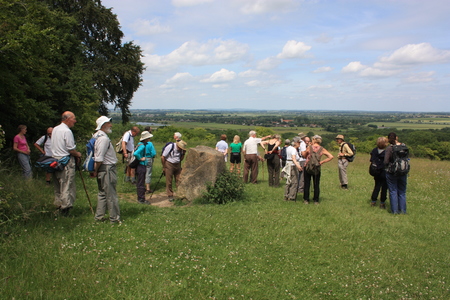The Jack Ibbott Memorial Walk
29th June 2013
 Photo: Jim Parke
Photo: Jim Parke
Jack Ibbott had been a long standing member of the Society for some 43 years. During this time he held most positions culminating as President. Sadly Jack died at the end of 2012, so this walk was organised to honour his memory.
The choice of walk was made easy by the fact that Jack, together with his wife Margaret, had compiled a booklet of 10 walks titled “Oxfordshire Rambles”. A walk from Dorchester Abbey seemed ideal; if the start time was appropriate we would finish in time to enjoy an afternoon tea in the Abbey Tea Rooms; a wonderful service run by volunteers who bake the most mouth-watering cakes. Try gooseberry sponge cake; it’s “to die for”.
The Abbey Tea Room has a sliding charge for cups of tea: 1st cup 60p, 2nd cup 50p, and 3rd cup 40p. How much tea must one drink before they start paying you? Could it be 8 cups?
A surprise bonus was that our new President elect, Sir Hugo Brunner, met us at the start. Our Chairman introduced him to the 25 walkers present.
Jack’s son, Michael, joined us. It was delightful to hear him reminisce about the walk and how he had done it many times before, with his parents, when he was a lad.
The route took us down to the River Thames to cross over the footbridge where the International Poosticks championship takes place every year. Then it was a steady climb up to Wittenham Clumps for spectacular views. Half-way to the top, Didcot Power Station came into view – looking as forlorn as a group of abandoned chess pieces; not even a wisp of ghostly steam came from the cooling towers.
From Round Hill, the highest point in the area, there are panoramic vistas over the surrounding countryside. A Toposcope, or Topograph, on a plinth gives direction and distance to visible features.
 Photo: Mike Ibbott
Photo: Mike Ibbott
After a brief pause, to regulate breathing and slow the heart rate, it was on and over the site of an Iron Age Fort. From the high ground it was down through Little Wittenham Wood, over the river and back to the start, this time following the Thames downstream until we met the river Thame.
Some walkers went straight to the tea rooms while others did the extra mile through the village of Overy to cross the Thame in front of the old water-mill.
This was a most enjoyable walk that some of us had done on previous occasions with Jack and Margaret.
